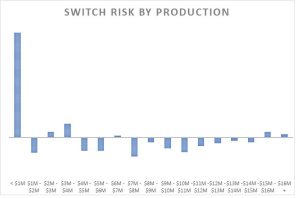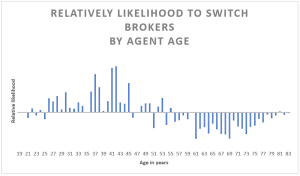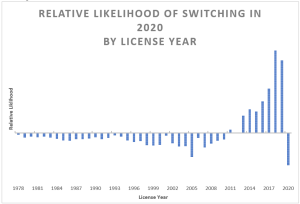Originally published on the RealTrends blog: https://lnkd.in/ghfHX5j
Volumes of articles have been written about why agents chose to leave their broker and join a new company with most being variations on the theme of the broker not upholding their value proposition through design or mismanagement. But what kind of agents react to these changes? Who is more primed to jump for a new opportunity and who will ride it out? Relitix has developed a sophisticated AI system for predicting agent departures by examining patterns of behavior but it’s also helpful to get a sense of mobility by looking at more obvious agent characteristics.
We analyzed agents in two markets to get some answers to these questions. It turns out that there are a couple factors which make a big difference and who might be an office switch risk.
It’s not production
We examined 3,489 agents who changed offices in Arizona during the first 11 months of 2020 to get a sense of the influence on annual production on propensity to change offices. Graph 1 below shows the relative propensity to switch offices when compared to the total agent population.

Figure 1. Likelihood to switch offices vs annual agent production, Arizona 2020.
A bar above the line indicates a group of agents more likely to switch, a bar below indicates those less likely. This graph tells us that, aside from agents producing less than $1M per year, production level has very little impact on propensity to change offices. Agents producing less than $1M per year are the exception and change offices at rates much higher than average. We’ll see later that this may be related to the age and tenure of these newer agents.
Age has a huge impact
We used a set of 1,100 agents who switched offices in 2019 and 2020 in Wisconsin, a state for which we have excellent birth date data, to examine the effect of age on likelihood to switch..The Bureau of Labor Statistics has published a study which shows the likelihood to change jobs declining exponentially with age. Will real estate agents follow this pattern? Figure 2 shows the result of our analysis.

Figure 2. Likelihood to change offices by agent age. Wisconsin 2019-2020
The bars above the line (indicating a group more likely than average to switch) rise from the 20’s peaking in the late 30’s before declining back to average by around age 50. Clearly age is a huge factor in determining who is most at risk of switching offices with “peak risk” between 35 and 42 years old. Those older than 50 are more likely to stay put.
Years in real estate is biggest determinant
Examination of initial license dates in our Arizona data set lets us plot risk of switching offices by years since original licensure.

Figure 3. Relative likelihood to switch offices in 2020 by license year. Arizona
The implications of fig 3 are obvious: newer agents are mobile. Agents in their first year in business are too overwhelmed to consider changing offices but the risk jumps dramatically for agents in their second and third year in real estate. Agents remain at a higher-than-average risk of moving until they reach their 8th year in business. After than they become less likely than average to move for the rest of their careers.
Management implications
Armed with this information, brokers are in a position to look at strategic management of their agent pools in a new way. A few take-aways:
– Office switching appears independent of production level. You don’t have to sweat it because your agents reach certain production milestones. They are moved more by other factors.
– Older, more experienced agents bring great stability to your agent pool. We demonstrated in another article that agents steadily grow their productivity through at least year 8. At the same time, they become increasingly likely to move. This is offset by the impact of higher producers on company dollar in traditional progressive-split brokerages.
– Younger, newer agents have a much quicker trigger-finger when it comes to changing brokerages. They are indispensable to replacing retiring agents (typically around 5-10% of a brokerage’s annual production will leave to retirement annually) and it is often much easier to recruit new agents into the business than recruit from the competition. These agents will have a positive impact on company dollar percentage. The downside: they require outsized time and attention to avoid losses to competition.
– Brokers should place special emphasis on retention programs aimed at agents in their first 3 years in real estate. Early identification of high-potential new agents and spending time and attention nurturing these future stars is especially import. Relitix has developed a system which can help with this identification.
Brokers should strategically plan and recruit for the type of agent pool they want, balancing the benefits and drawbacks which come with differences in production, age, and experience. Striking the optimal balance between stability and grow will be key to achieving the brokerage’s long-term goals.

